"This is Japan," a hot spring with a breathtaking views made possible by rich nature and a long history
Onsen is the Japanese word for hot spring; hot springs contain specific ingredients and gush forth from the ground. Soaking in a warm bathtub not only reduces weariness and relaxes the body, but the ingredients in hot springs can also help with a variety of other symptoms.
Since ancient times, many people have visited places where there are hot springs for medical treatment and sightseeing, resulting in the development of a distinct local hot spring culture. Hot springs have a wide range of characteristics, from secluded hot springs that are one with nature and full of rustic beauty to hot spring resorts where you can stroll through the town full of stores.
There are many unique hot spring resorts in the Tohoku region, but the one described here is a secluded spot tucked away in the midst of lush nature that has piqued the interest of hot spring enthusiasts from all over Japan, who wish to visit at least once because of its uniqueness.
Nostalgic scenery with a traditional Japanese vibe. The hot spring baths provide an open-air bathing experience with breathtaking views of the great outdoors. Each of these hot springs is recognized for its "Japanese-ness" and "Tohoku-ness."
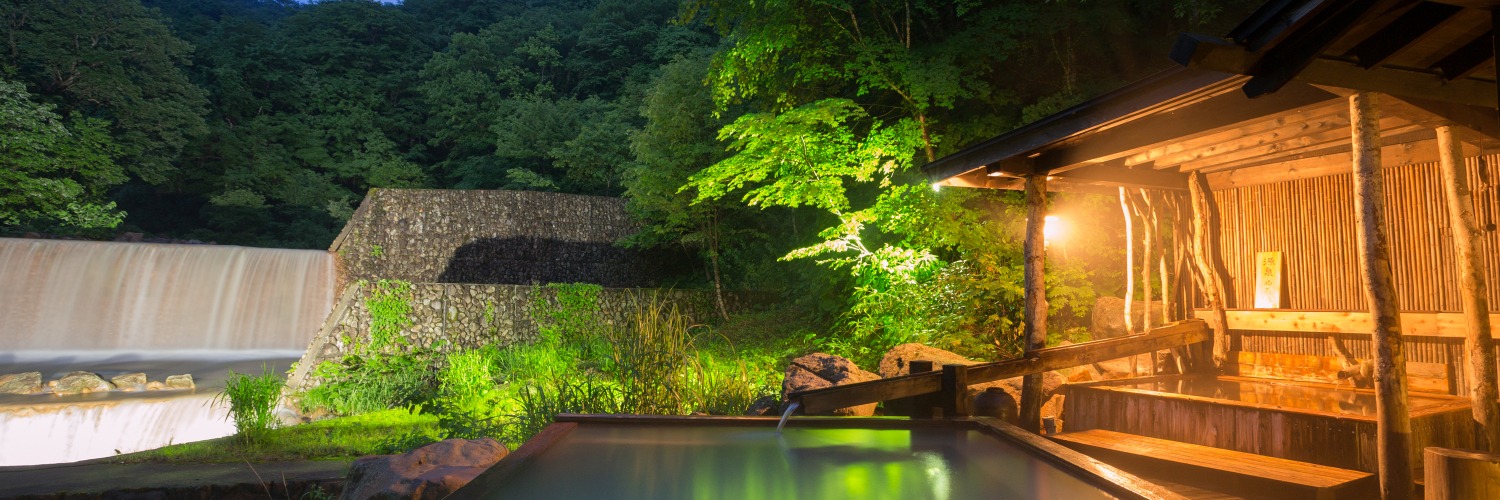
Nyuto Onsenkyo, a well secluded hot spring popular with hot spring enthusiasts all across Japan
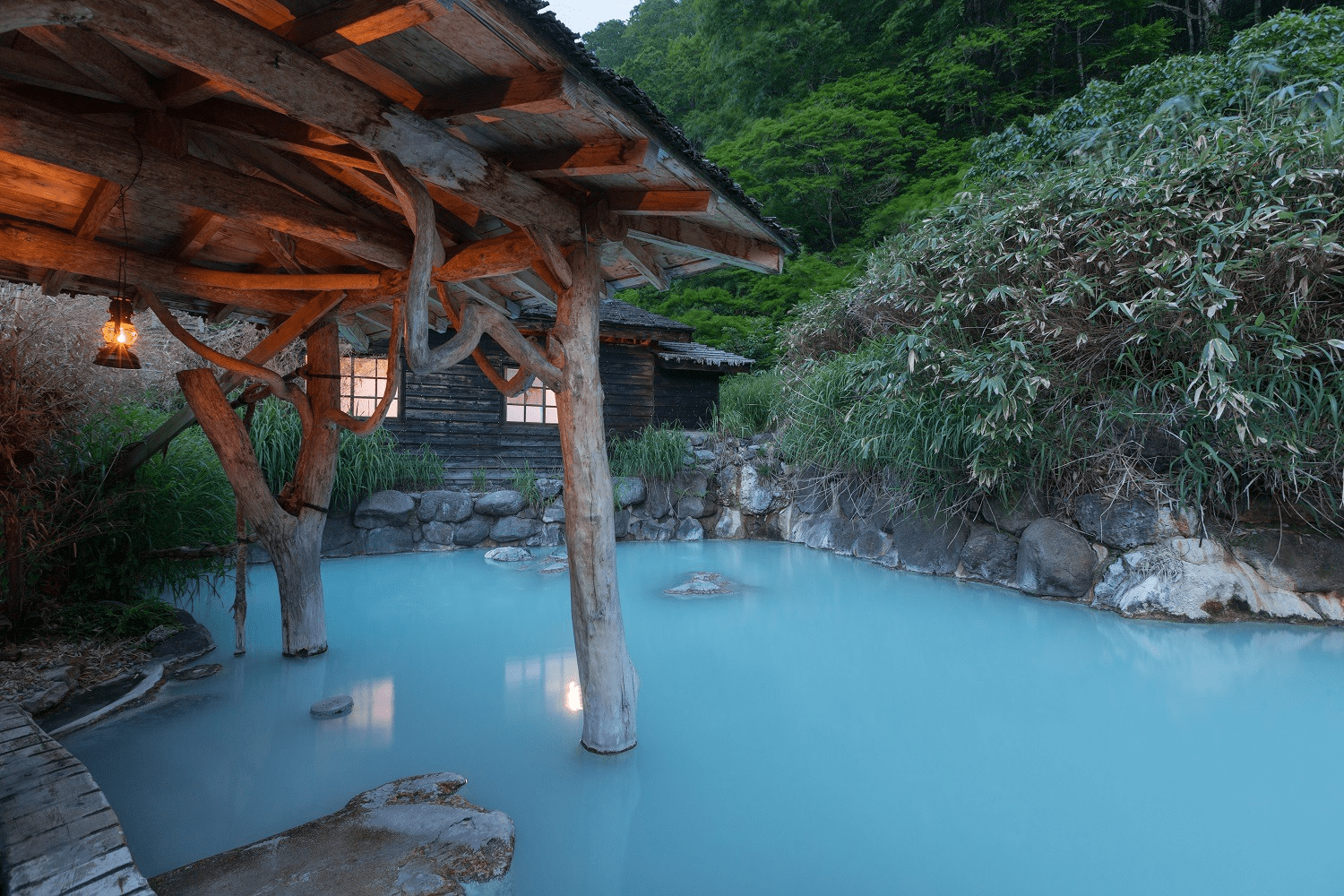
(Image courtesy of Nyuto Onsen Association)
Take the Akita Shinkansen to Akita Prefecture, then take a 50-minute bus ride from JR Tazawako Station. Nyuto Onsenkyo, a popular hot spring resort, promises to offer you with an experience that exceeds your expectations, which increases in proportion to the duration of your travel time. This hot spring resort is one of Japan's most popular and consistently ranked first by many media outlets.It has two major attractions.
One is that in this untouched nature, there are hot springs with a wide variety of spring qualities. Nyuto Onsenkyo is located at the foot of Mt. Nyuto in Towada-Hachimantai National Park, where virgin beech forests still exist. There are over ten varieties of hot springs with a wide range of spring qualities, and each of the seven hot spring inns scattered around the area has its own source, making it unique even within Japan.
For example, "Tsurunoyu Onsen," the oldest of the hot spring resorts, offers four distinct types of springs with varying qualities. Although they all appear cloudy, they each contain various ingredients, allowing you to enjoy four distinct textures and benefits. The open-air baths, with their cloudy white water gushing out from beneath the feet, are particularly well-known as being symbolic of Nyuto Onsenkyo.
Taenoyu, a modern Japanese-style hot spring hotel with historical furnishings, features two sources of hot spring water. The first is "Kin-no-Yu," a cloudy water that changes color depending on the weather, and the second is "Gin-no-Yu," a clear, colorless water that feels soft against the skin, and each has its own set of benefits.
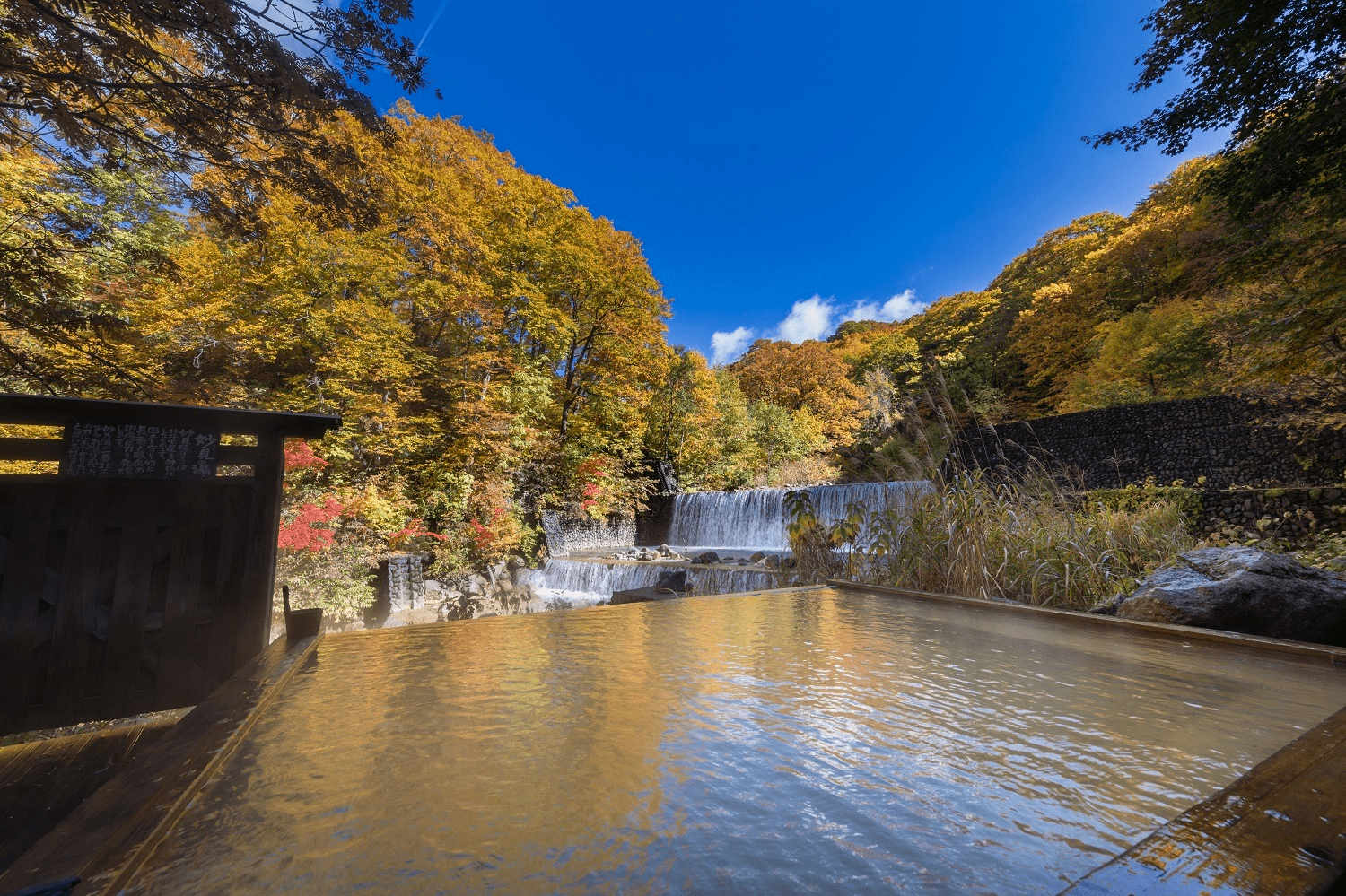
(Image courtesy of Nyuto Onsen Association)
Kyuka Mura Nyuto-Onsenkyo, the hot spring resort's most modern facility, gets hot water from two sources. Each of them fills the large bathtubs to the full, offering a pleasant greeting to visitors who want to soak in the hot spring water.
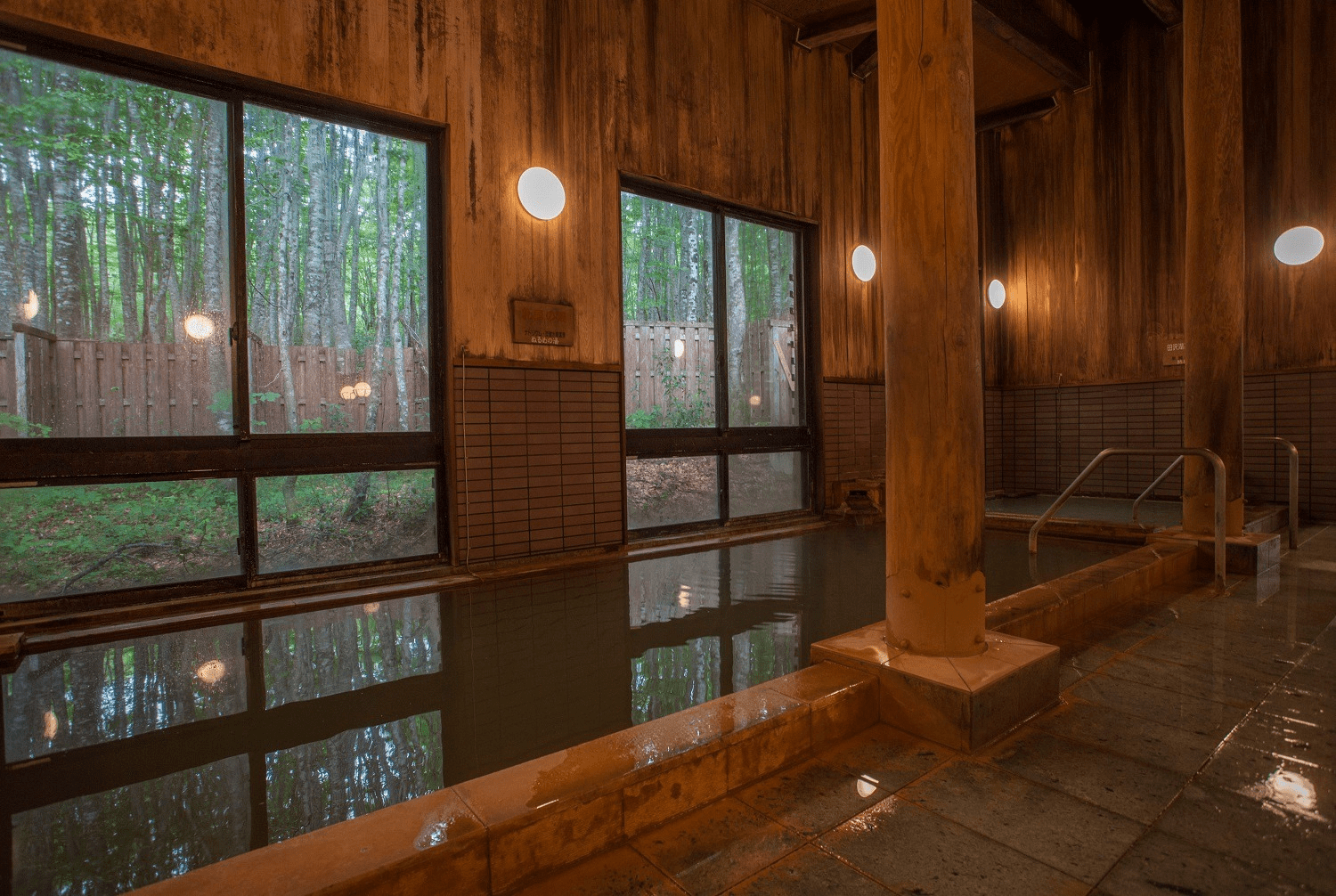
(Image courtesy of Nyuto Onsen Association)
Another feature of Nyuto Onsenkyo is that it still has the feel of a traditional hot spring resort. The hot springs at Nyuto Onsenkyo have long been known as providing a "hot-spring cure" for disease and injury, with many people staying for long-term treatment. The nostalgic emotions of the therapeutic baths merge wonderfully with the natural surroundings, creating a stunning traditional Japanese landscape.
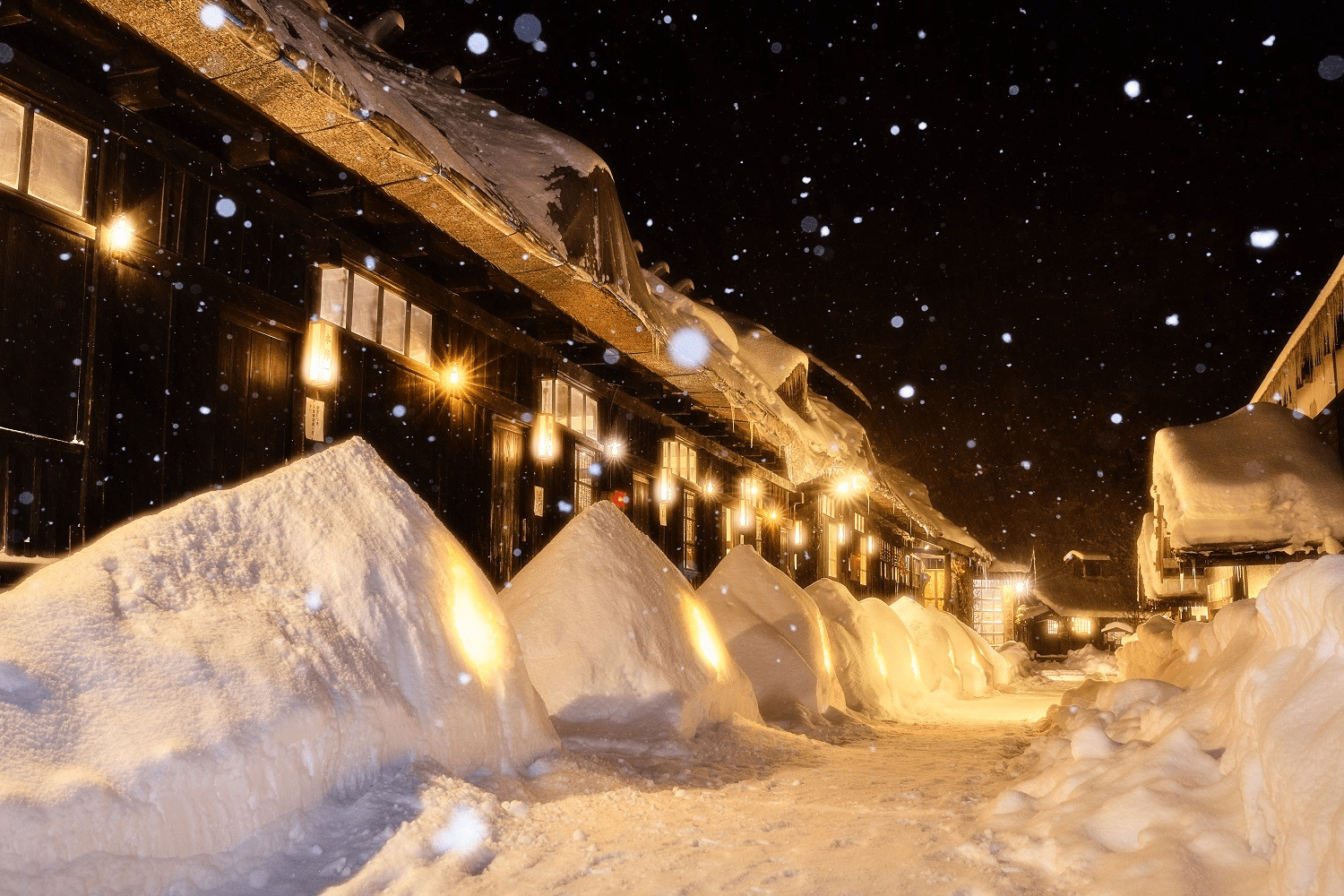
For example, the aforementioned Tsurunoyu Onsen is a historic hot spring that was used as a therapeutic bath by the Akita feudal lord during the Edo period. The "Honjin," a thatched-roofed row house where samurai defending the feudal lord used to lodge, still exists, and guests can stay in a room much like in the past. Kuroyu Onsen, which possesses the most hot spring water in the hot spring resort, is also a historical inn that has been used as a therapeutic bath since the Edo period. The thatched-roof and cedar bark-roofed inns and bathhouses grouped together provide the impression of a traditional hot-spring cure. Ookama Onsen, housed in a relocated wooden elementary school building, is likewise unusual.
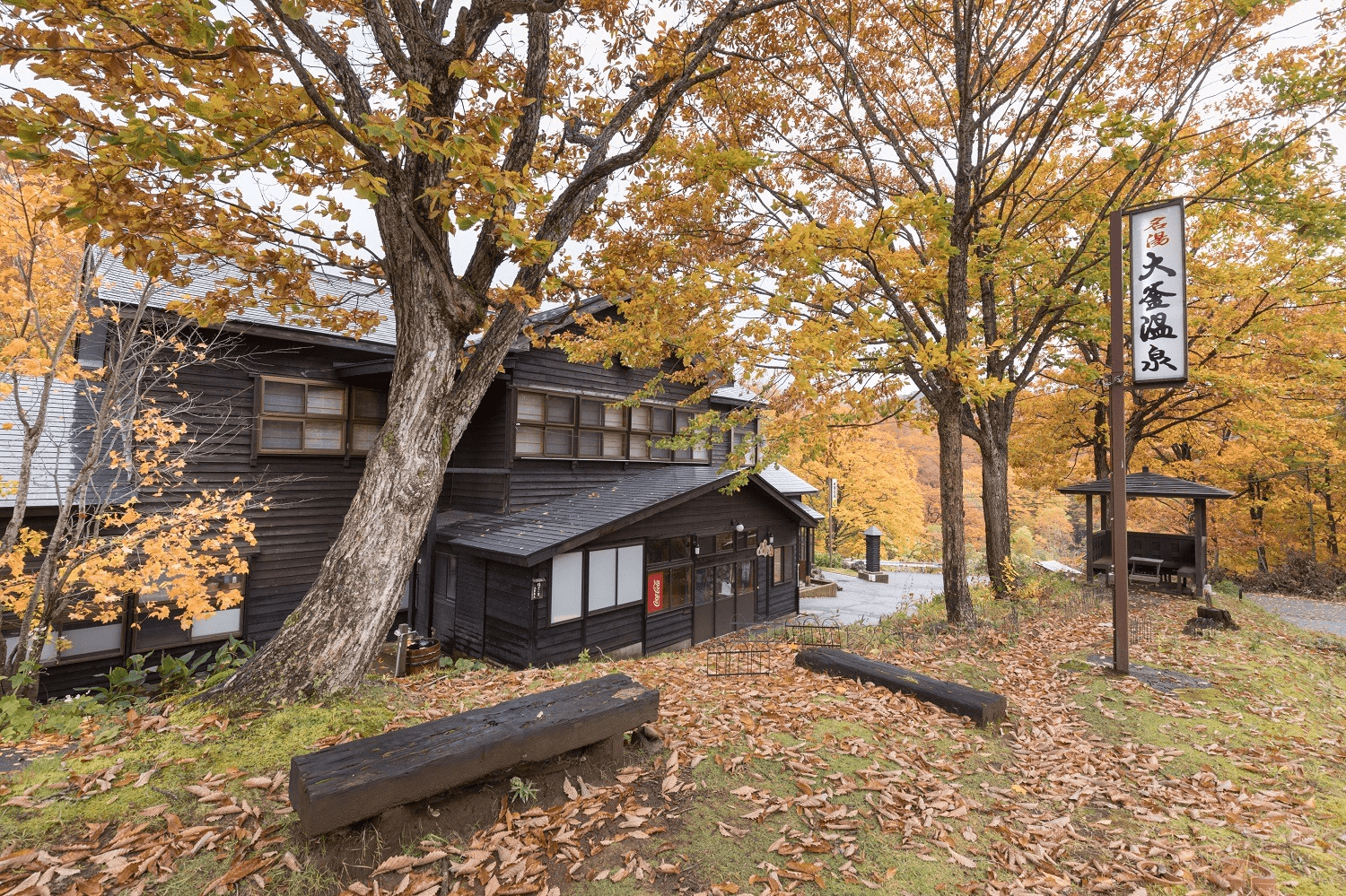
(Image courtesy of Nyuto Onsen Association)
Ganiba Onsen is well-known for its open-air baths hidden in a virgin beech forest, while "Magoroku Onsen" offers hot spring facilities along the river, away from the inns, each expressing the feeling of a traditional therapeutic bath (Magoroku Onsen is closed for renovation work).
To enhance your enjoyment of these distinctive hot springs, a ticket book called "Yumeguri-cho," which allows you to soak in the hot springs of seven different inns at a discounted rate, is available for purchase (for overnight guests only). Each hot spring resort is connected by the "Yumeguri-go" bus service, so it's ideal to board the bus with your "Yumeguri-cho" ticket book in hand to explore some of Japan's most symbolic secret hot spring resorts.
Ginzan Onsen boasts an exceptional presence of wooden houses that combine Japanese and Western styles
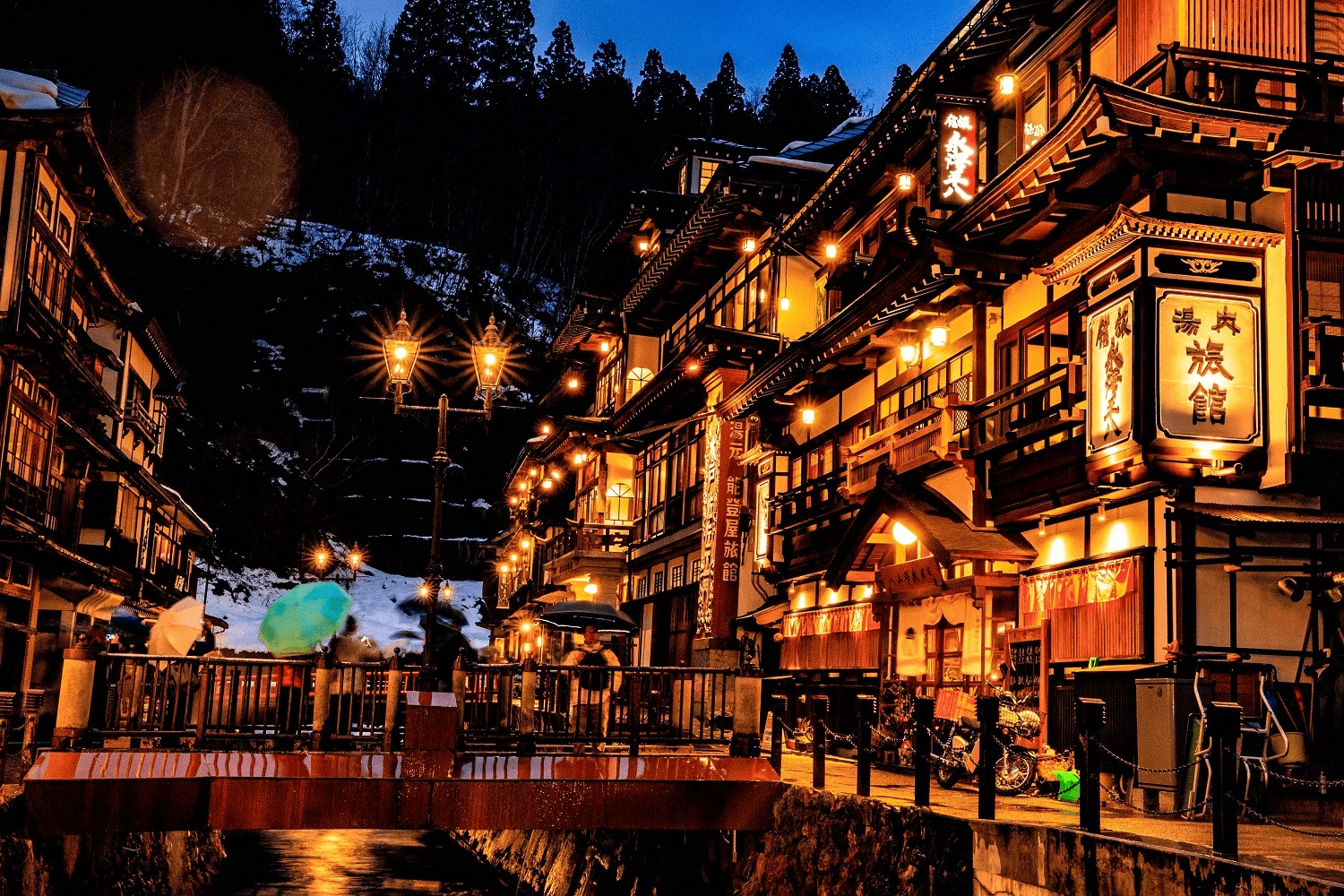
Ginzan Onsen, located in Obanazawa City, Yamagata Prefecture, near the border with Miyagi Prefecture, is nestled away in the mountains of the Ou Mountains and attracts many people from Japan and abroad to enjoy its unique landscape. What distinguishes this hot spring resort is the picturesque townscape with buildings built approximately 100 years ago. The three- to four-story wooden structures, which are a combination of Japanese and Western styles, are grouped together on both banks of the Ginzan River within a 300-meter distance, creating an astonishing atmosphere reminiscent of a movie set.
The name "Ginzan Onsen" originates from the fact that there was once a silver mine nearby. The hot spring was discovered over 400 years ago and became a popular spot for mine workers to recover and take therapeutic baths.
A considerable volume of hot spring water gushed out from the source in 1926, during a period of modernization, and all hot spring hotels rebuilt their structures around that time. The wooden houses that incorporated the Western style that was fashionable at the period were a unique blend of Japanese and Western architecture, and they are frequently called as "Taisho Roman" (Taisho Romanticism).
After getting off the bus at the Ginzan Onsen Bus Stop and strolling down the slope, you will arrive at Shirogane Bridge, the entrance to the hot spring resort area. From there, the view changes dramatically, with the slowly flowing Ginzan River and historic buildings on both banks! Enjoy the environment as you stroll along the river. If you are staying at Ginzan Onsen, after checking in, put on a yukata and geta (Japanese wooden clogs) provided by the inn and walk around the hot spring resort town in your yukata for an even more authentic Japanese experience.
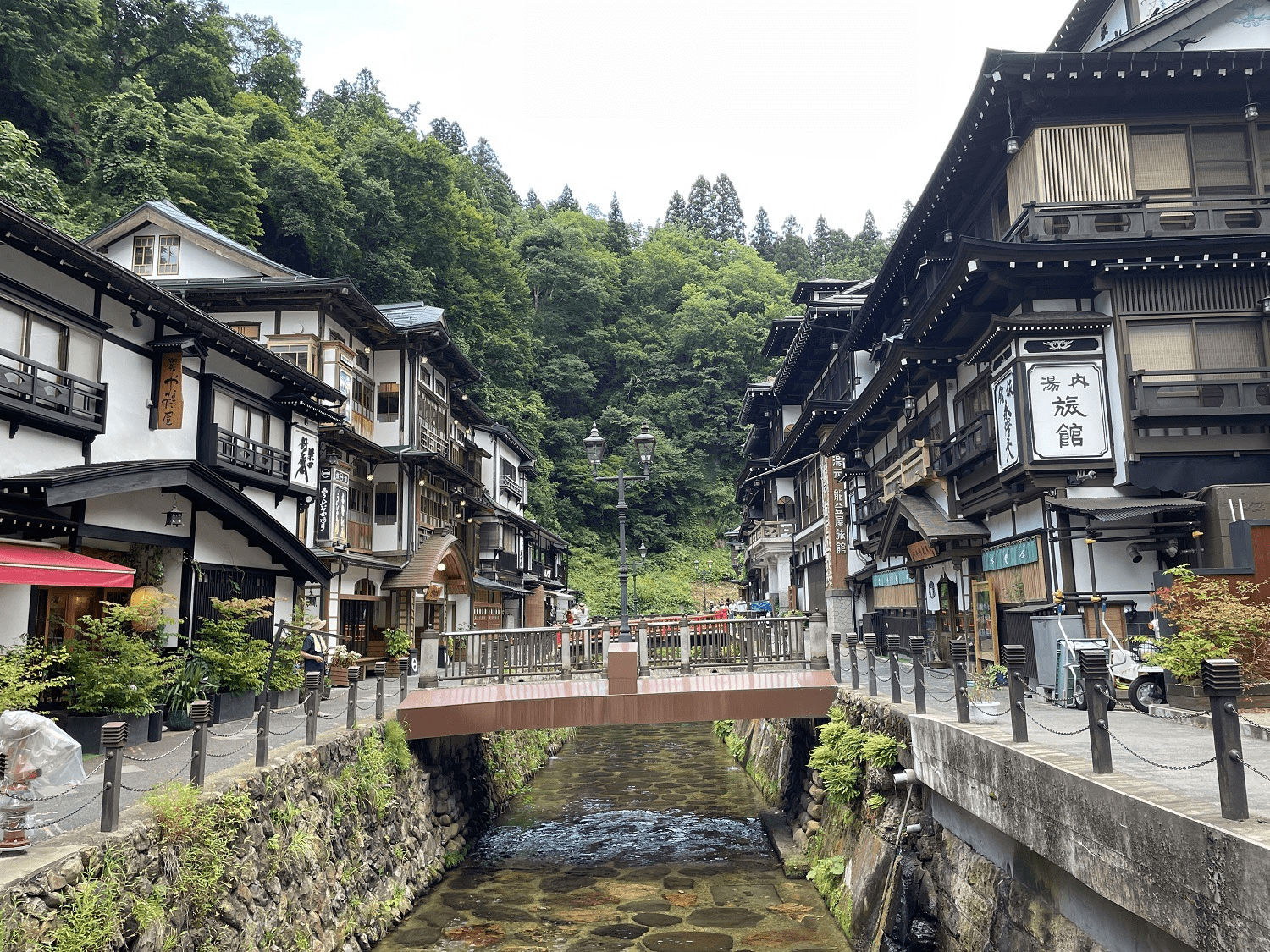
(Photo courtesy of Obanazawa City)
The view in the hot spring resort area is beautiful during the day, but it is just as stunning at night. From sunset onward, the town is illuminated by gas lamps, and the orange lights streaming out of the hot spring inns warm the atmosphere. Another feature of Ginzan Onsen is that the scenery changes depending on the season. The most popular season is winter, when the town is blanketed with snow. Dusk, when the silvery white world is illuminated by gas lighting, intensifies the romantic ambiance.
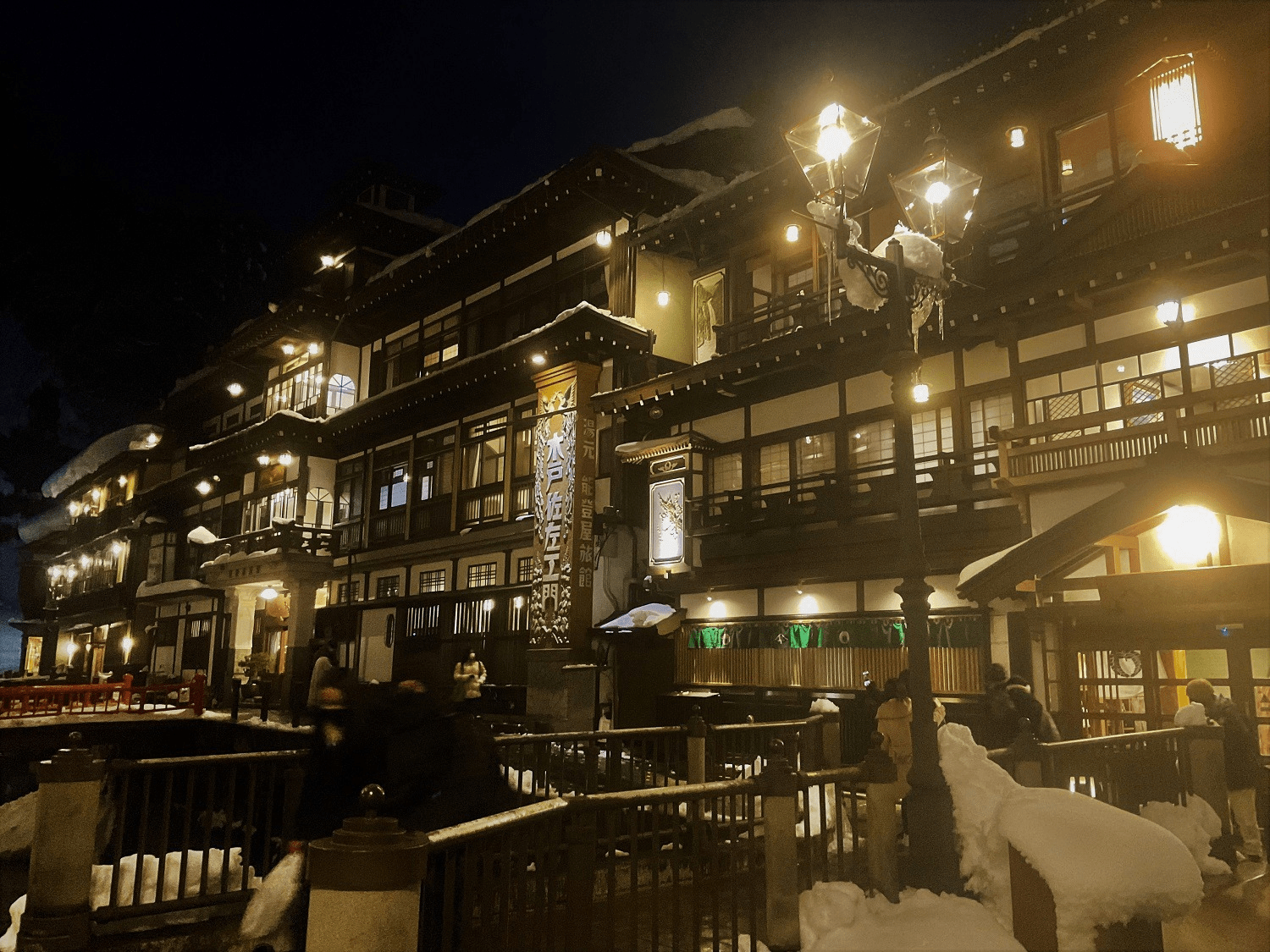
(Photo courtesy of Obanazawa City)
You can stay overnight at one of 13 inns in the hot spring resort area. Among these, Notoya Ryokan is well recognized as the face of Ginzan Onsen. The three-story wooden structure was completed in 1921 and is designated as a Tangible Cultural Property of Japan. The warmth of the wood evokes a sense of history, and there are many sights to view inside the inn.
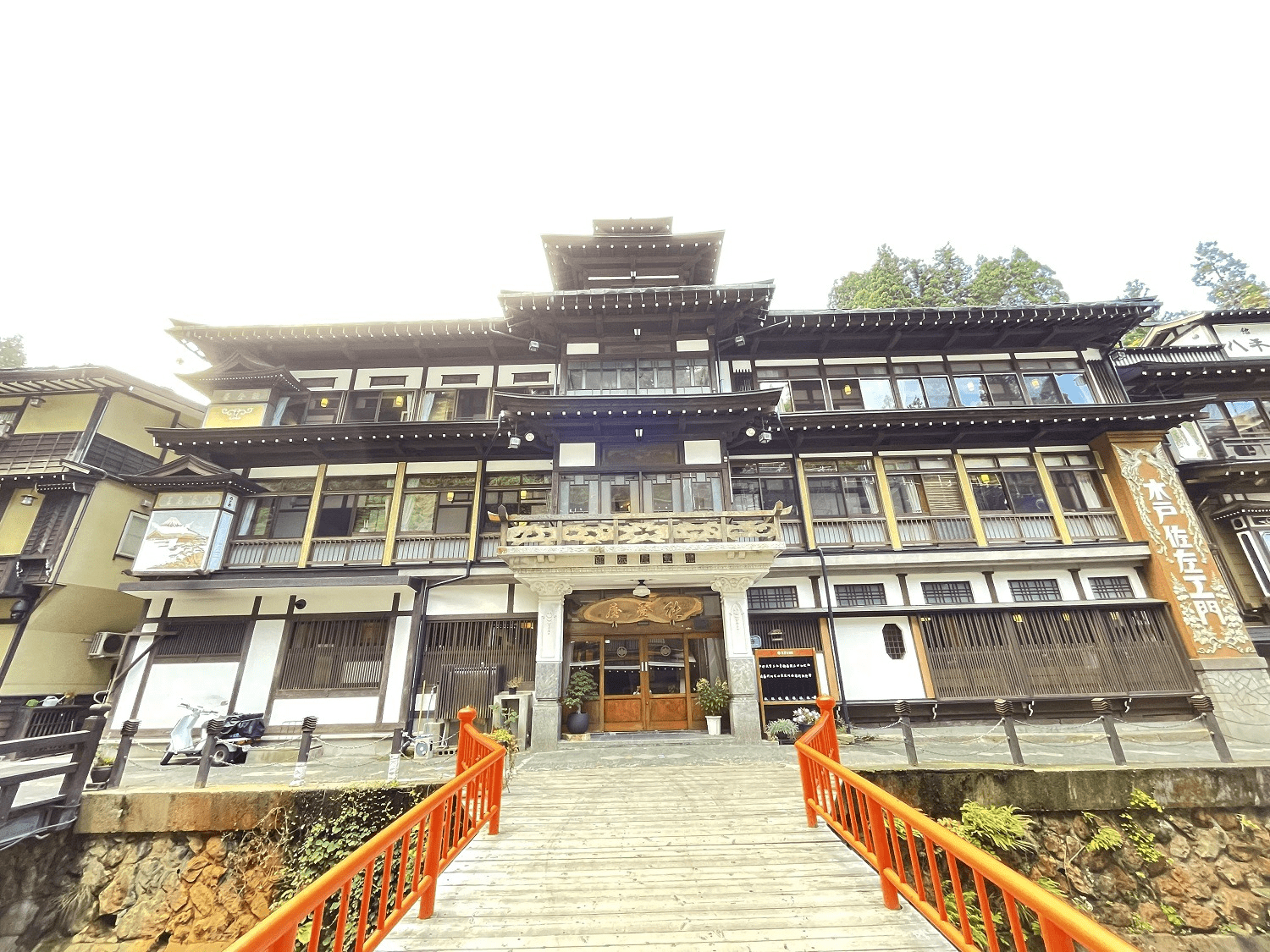
(Photo courtesy of Obanazawa City)
The stylish Fujiya was designed by world-renowned architect Kengo Kuma and renovated from a Taisho-era structure,
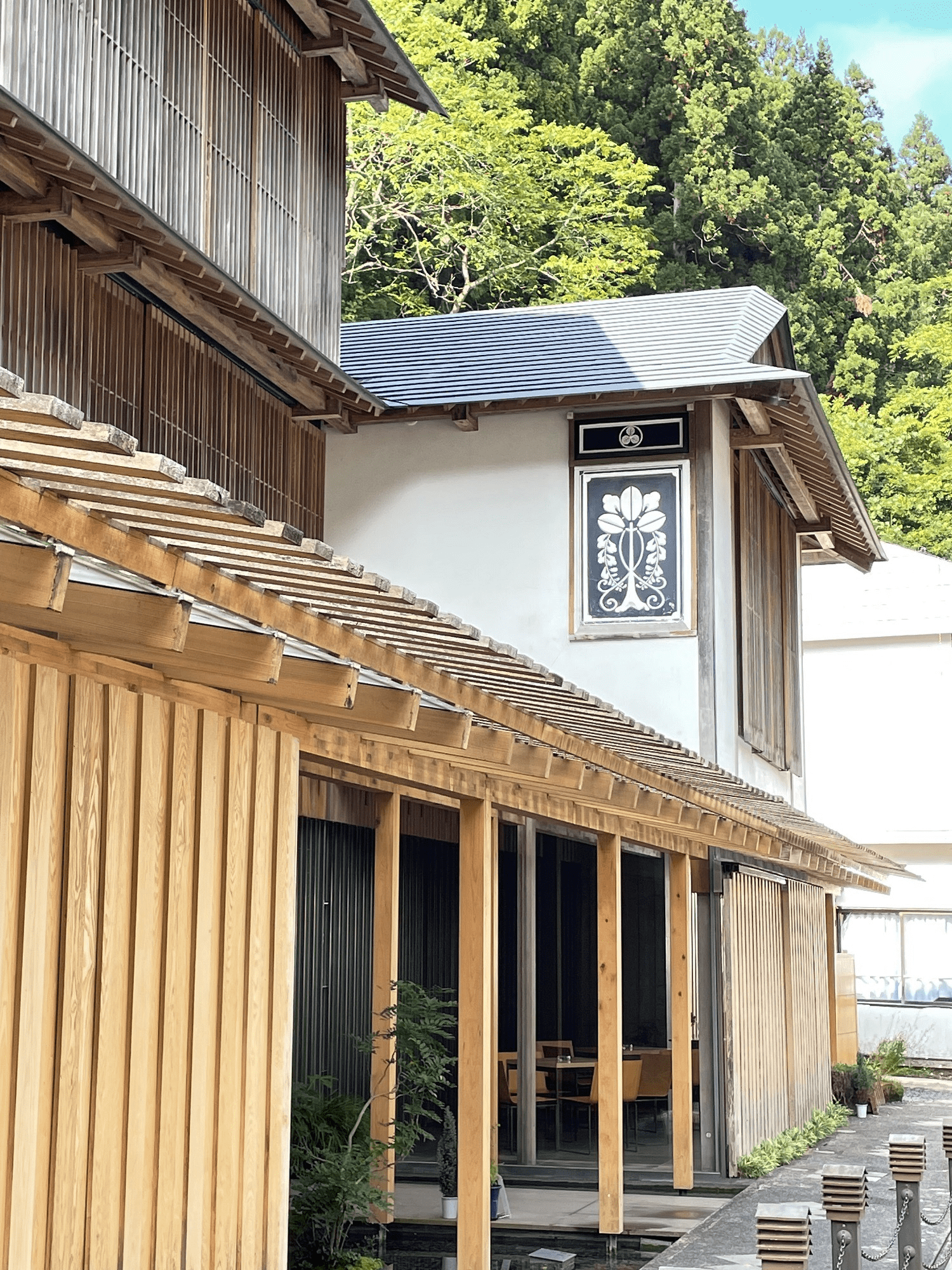
(Photo courtesy of Obanazawa City)
while Honkan Kosekiya was renovated with a more nostalgic feel and opened in 2022, while retaining its appearance registered as a Tangible Cultural Property. Each inn is establishing its own unique hospitality while preserving the scenery that makes up the hot spring resort.
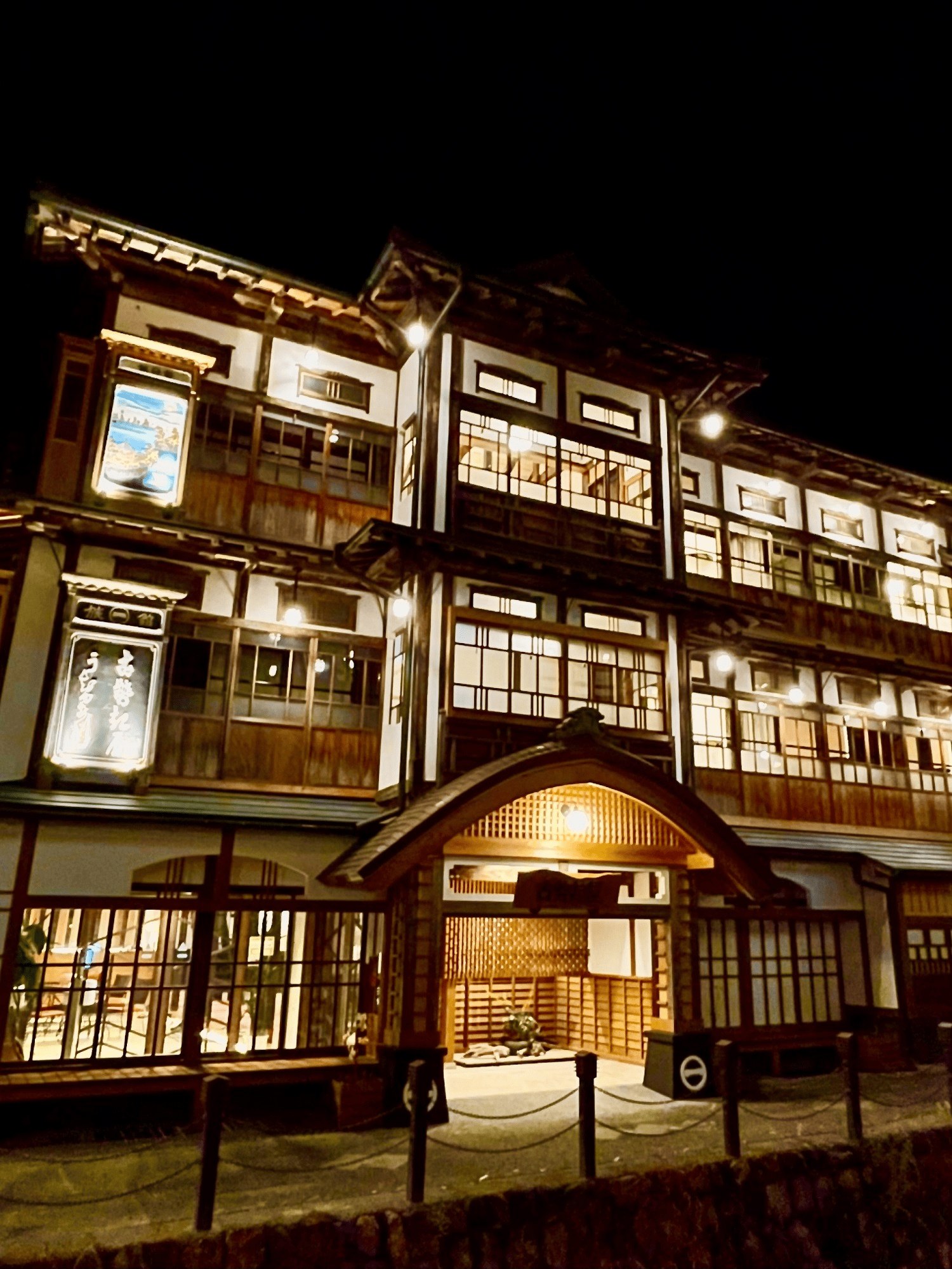
(Photo courtesy of Obanazawa City)
The hot spring water is clear and colorless, and it is called "Atatamari no Yu" (warmth-inducing waters). It contains many hydrating elements that keep the skin moist and firm after a bath. Each hot spring inn has a distinct style and scenery for its bathhouses. For example, the bathhouse at "Showakan," located literally in the center of the hot spring resort, is well-known for its "Tenku Furo" (open-air bath in the sky)where you can enjoy the hot spring water from the top floor with a view of the resort. There are also public bathhouses in the hot spring resort area where guests can spend the day and bathe for a fee.
At Ashinomaki Onsen, you can forget about time and relax in the renowned hot springs in nature
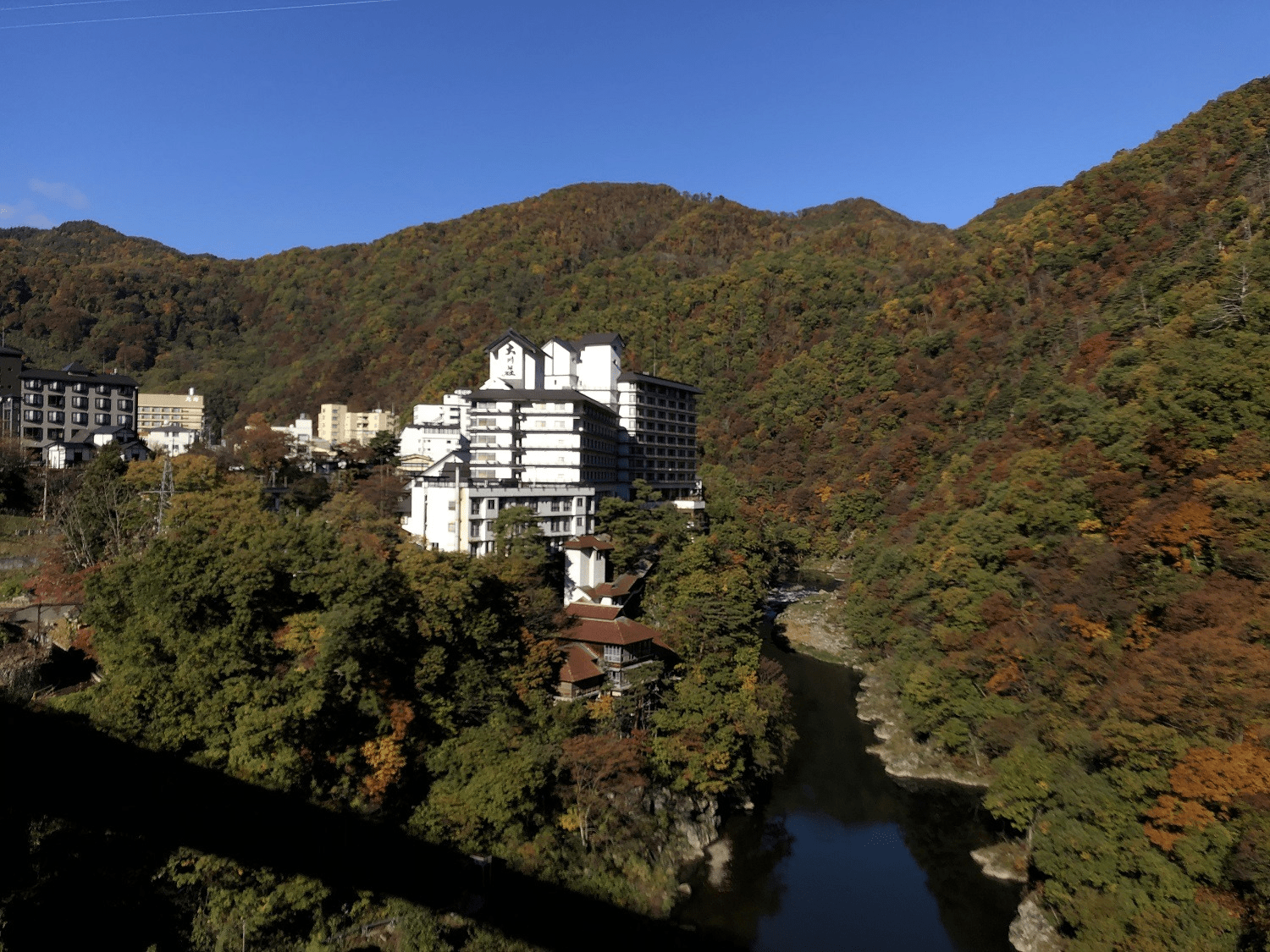
It takes around 30 minutes by car or train from the center of Aizuwakamatsu City, Fukushima Prefecture. Ashinomaki Onsen, which has been around for well over a thousand years,is now easily accessible, yet it was once regarded as a phantom hot spring resort due to its difficulty of access. The hot spring resort is located on a hill overlooking the slow-moving Aganogawa River in a peaceful mountainous environment endowed by nature.
The most appealing aspect of Ashinomaki Onsen is the breathtaking view of nature and the exceptional quality of the hot springs. The hot spring resort is located on a deep cliff carved by the Aganogawa River. Looking out from there, the river's surface sparkles emerald green, and mountains loom across it. Visitors can enjoy the valley's splendor in all four seasons, as it is surrounded by lush surroundings.
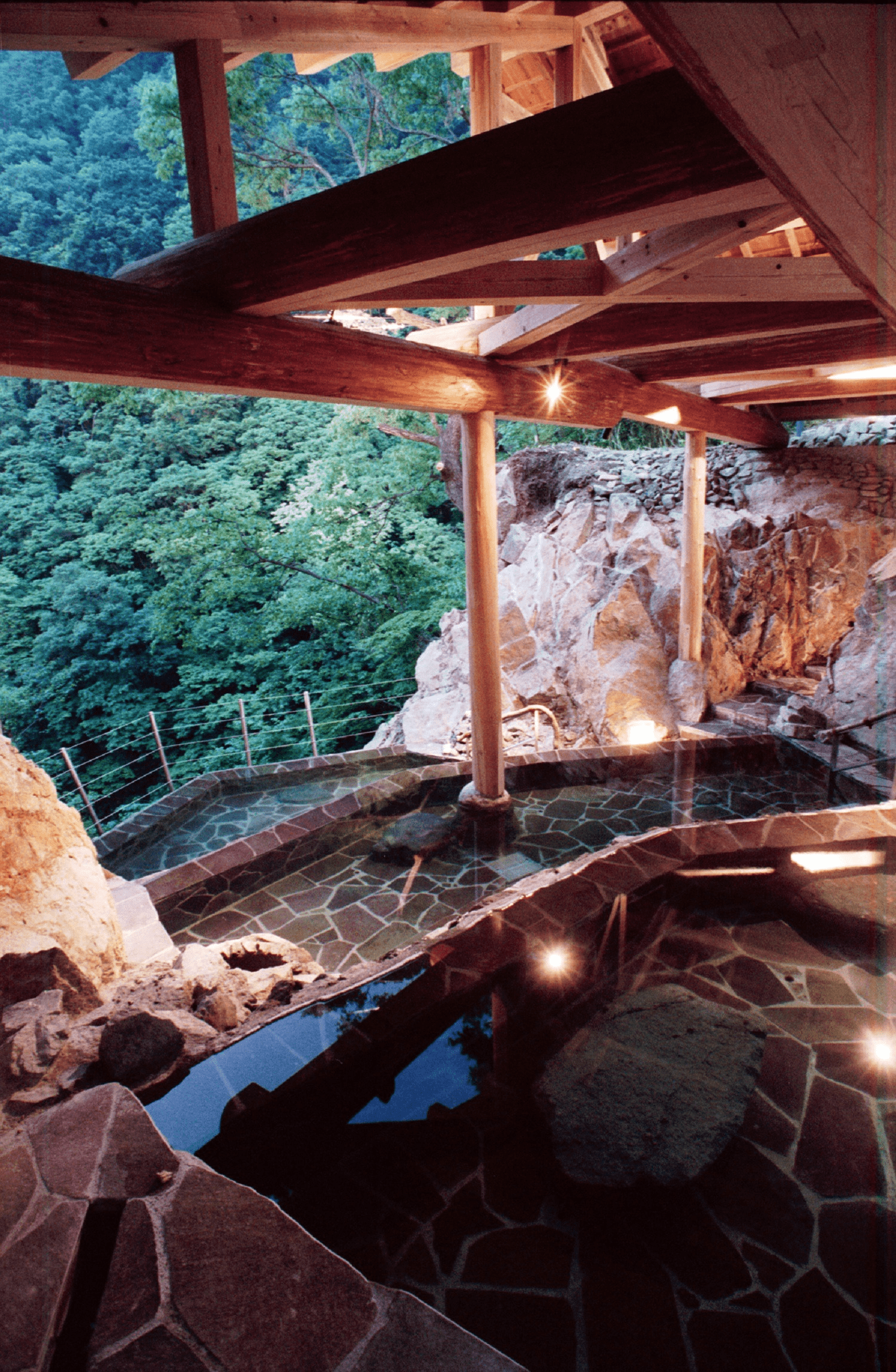
You can also enjoy the breathtaking view while bathing in the hot spring. The hot spring water in Ashinomaki Onsen is renowned for its high temperature at the time of gushing, abundant supply, and good quality. A "Japanese hot spring" is defined by the experience of immersing oneself in hot spring water and becoming one with the stunning surroundings.
Currently, Ashinomaki Onsen has eight hot spring inns. From cozy small-scale inns to large-scale inns with over 100 guest rooms, there is an inn for everyone.
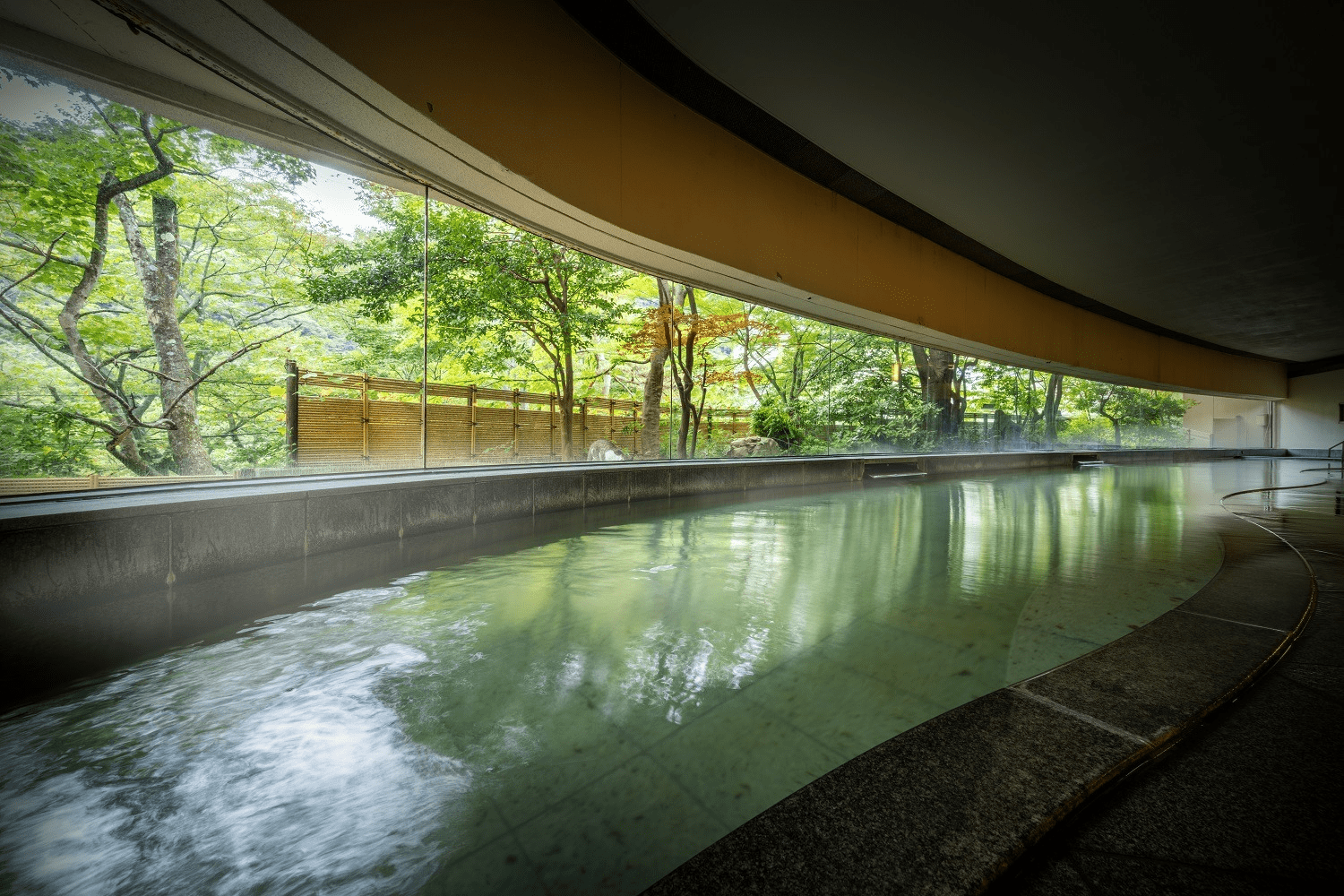 One inn that has gained popularity in recent years is Okawaso, which has the most guest rooms in the hot spring resort area. After going through the door, you will find yourself in a spacious atrium space. Stairs and passageways lead over a pond with water at the bottom, where a woman dressed in a kimono plays the shamisen on a floating stage with a red carpet in the center. This unusual area has become a topic of talk on social media due to its resemblance to the Infinity Castle in the popular manga Demon Slayer, and many fans have come to stay and take pictures on the floating stage.
One inn that has gained popularity in recent years is Okawaso, which has the most guest rooms in the hot spring resort area. After going through the door, you will find yourself in a spacious atrium space. Stairs and passageways lead over a pond with water at the bottom, where a woman dressed in a kimono plays the shamisen on a floating stage with a red carpet in the center. This unusual area has become a topic of talk on social media due to its resemblance to the Infinity Castle in the popular manga Demon Slayer, and many fans have come to stay and take pictures on the floating stage.
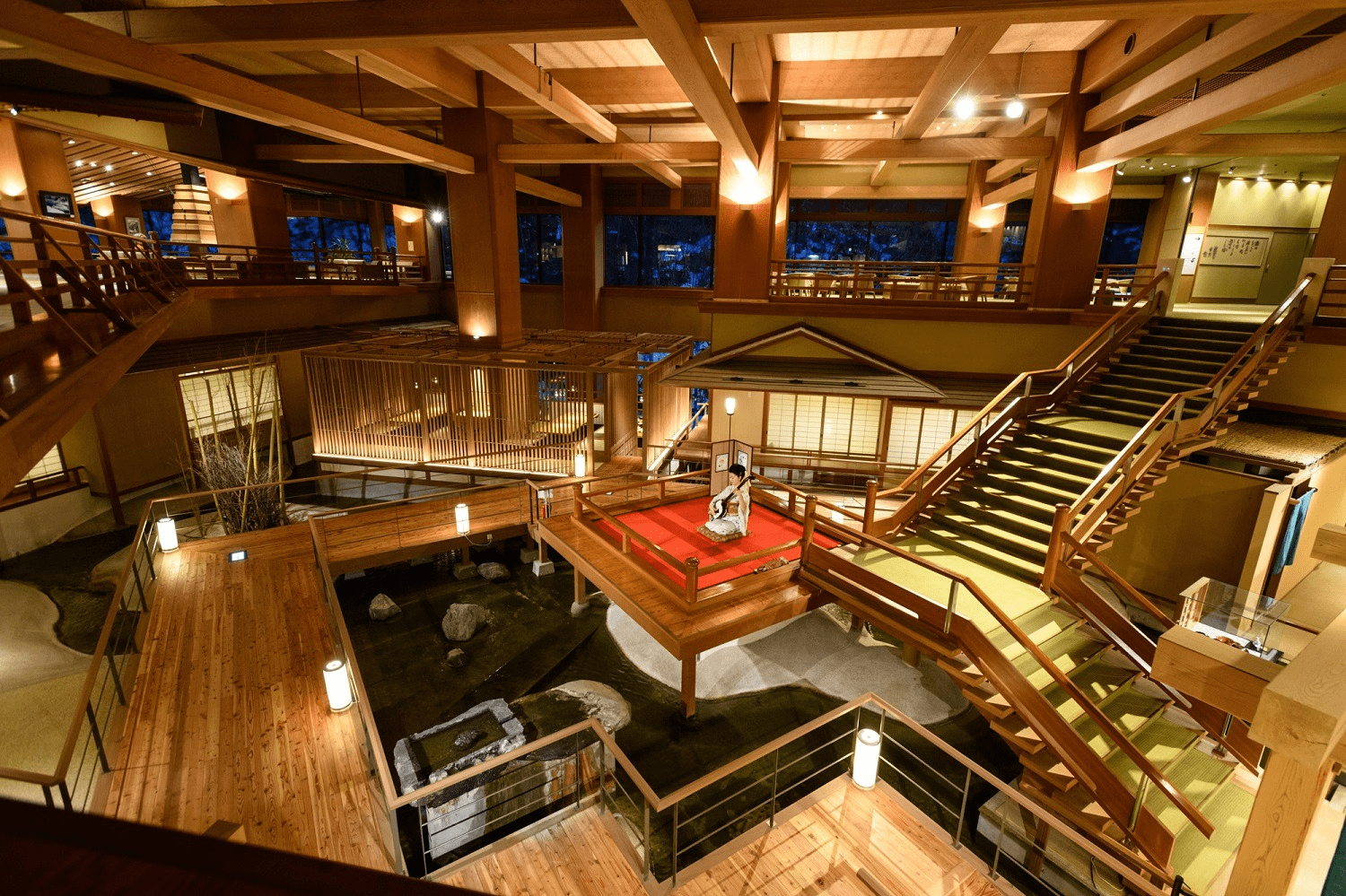
Visitors can also soak in the 30-meter-long bathtub and enjoy dynamic views, as well as open-air bathing in the mountain stream observation bath in Marumine Honkan, which overlooks a magnificent valley through an all-glass window, or in Keizan, a private open-air bath with a spectacular view of the river and mountains.
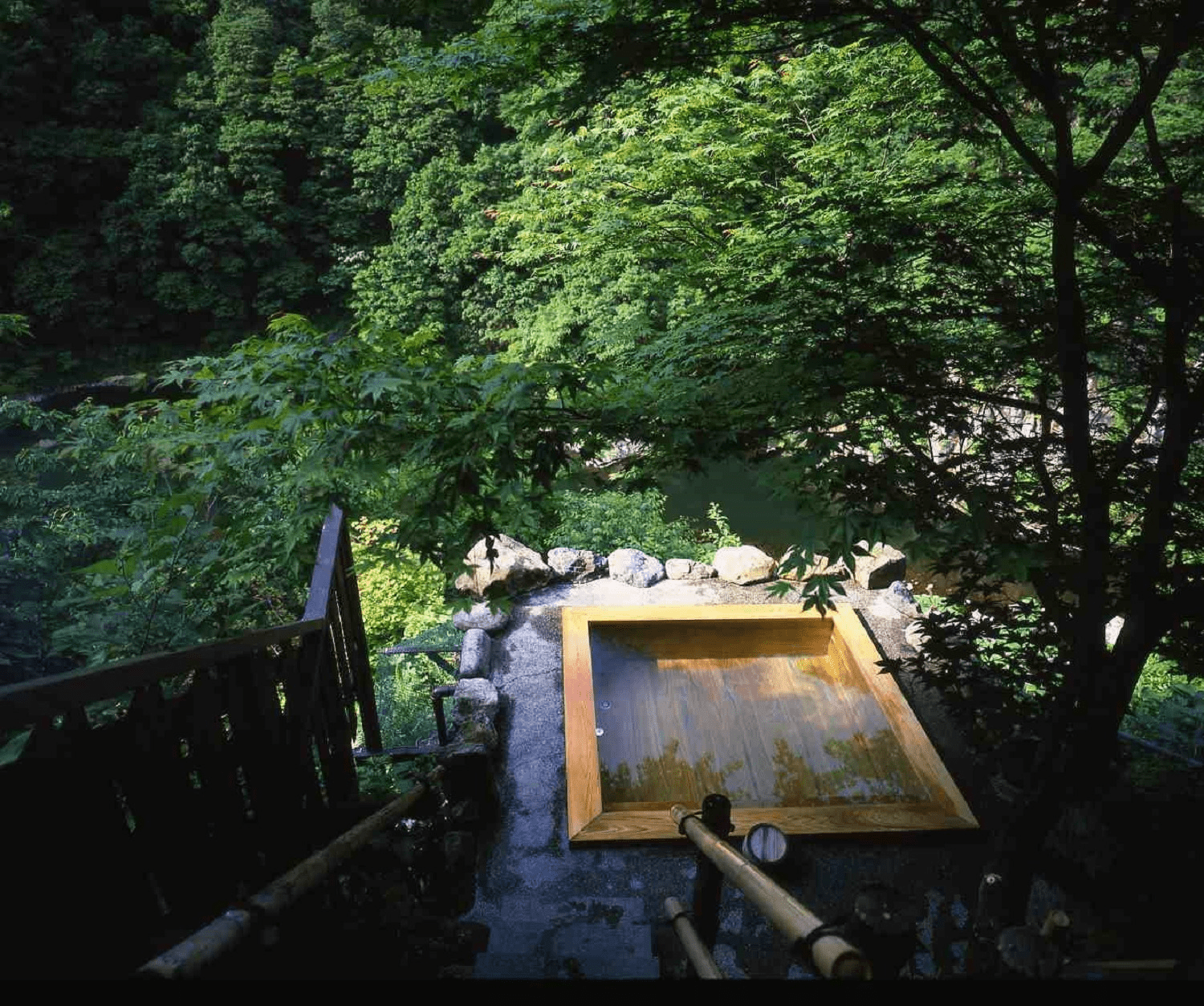
To thoroughly appreciate Ashinomaki Onsen, we recommend going for a stroll before or after your stay. There are footbaths at Kagayaki Park, Ashiyu Ashipoppo, and Konsei Shrine, Kodakara-no-Yu, where you can relax while strolling.
In addition, near Ashinomaki Onsen there are many sightseeing attractions that represent Aizu. Some of the must-see sights of Ashinomaki Onsen include Ouchi-juku, an inn town with traditional thatched-roof houses, and Tsurugajo Castle, Japan's only castle with a red-tiled tower. If you take the train to any of these locations, be sure to say hello to "Sakura," the cat who serves as station master at Ashinomaki Onsen Station (Aizu Railway), the closest station to the hot spring resort.
Basic Onsen Etiquette to Know Before Bathing
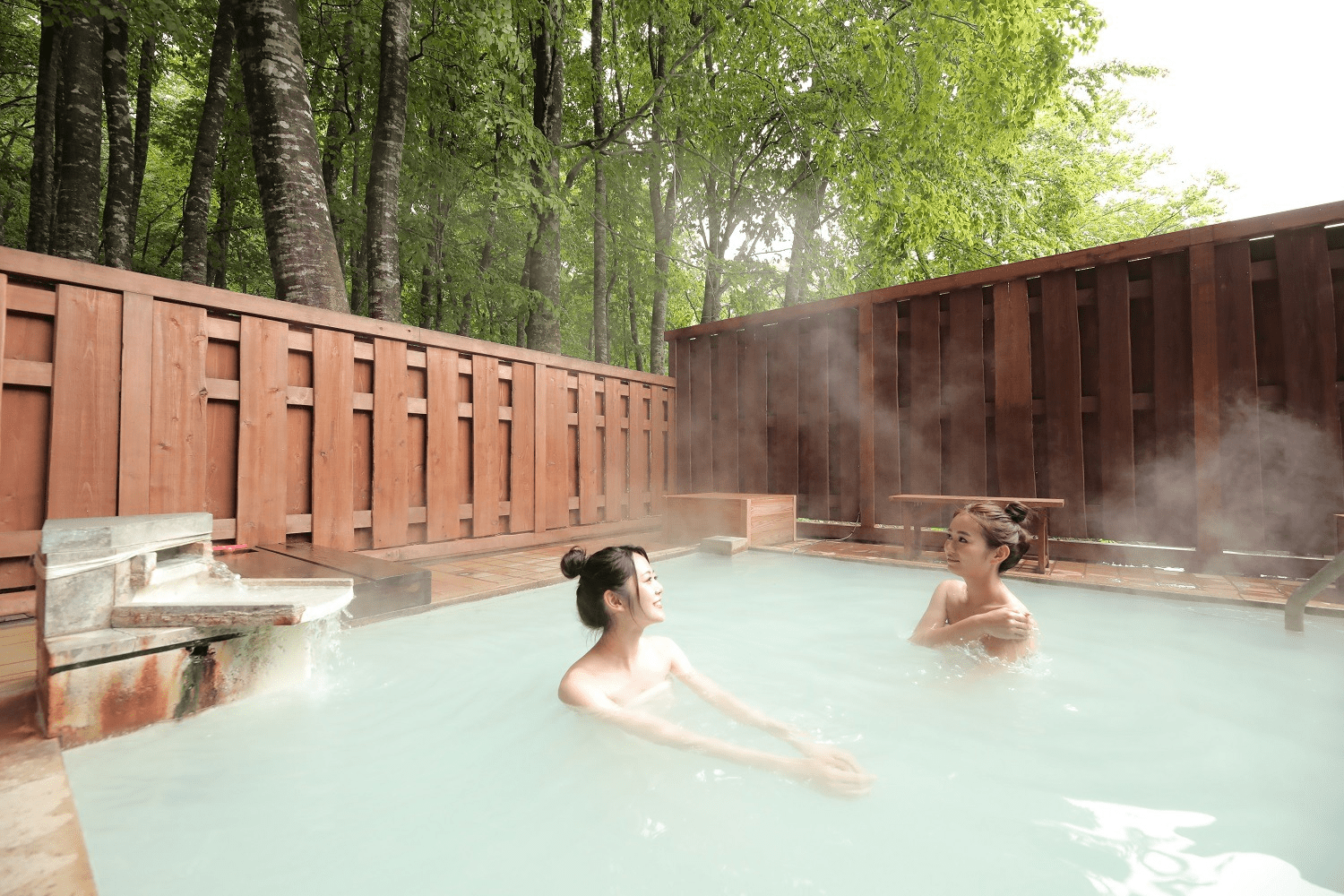
(Image courtesy of Nyuto Onsen Association)
Japanese people are very accustomed to hot springs, but those who have never bathed in one, such as visitors from other countries, may be unfamiliar with how to enter a hot spring or the etiquette involved. Here are some fundamental guidelines for bathing in a hot spring.
If you are staying at a hot spring hotel, take the towel and bath towel provided in your guest room and proceed to the bathhouse. The entrance to the bathhouse is frequently marked by a blue curtain for men and a red curtain for women. Inside the changing rooms, there are baskets for storing personal goods; place your bath towels and clothes in the baskets; make sure you remove your underwear as well. If you have valuables, use the lockers in the changing room.
When you're ready, grab a towel for washing and go inside the bathhouse. Bathhouses are usually separated into two types: indoor baths, which have bathtubs inside, and open-air baths, which have bathtubs outside. We propose that you bathe in the indoor baths first because the open-air baths may not have showers or washing areas to clean your body.
Before soaking in the bathtub, wash your body and hair in the washing area to avoid contaminating the water. You are welcome to use the shampoo and other goods available in the washing area. When using the shower in the washing area, take care not to splash hot water on anyone around you. If you have long hair, tie it after washing it to avoid hair getting into the bathtub.
Pour hot water over yourself before entering the bathtub to avoid a sudden increase in blood pressure. Fill a bucket with hot water from the bathtub and slowly pour it over your feet, which are far from your heart, to adapt your body to the heat of the water. After that, carefully immerse yourself in the bathtub, beginning with your feet, and take a half-body bath in which you soaked in the hot water up to your waist. Once you've become used to it, soak up to your shoulders and take a full-body bath. Enjoy the sensation of hot spring water while admiring the surrounding environment. Please note that as a general rule, you are not allowed to put the towel you used to wash your body into the bathtub.
Soaking in a hot spring bath for too long, while beneficial to your health, might trigger a rush of blood to the head or leave you feeling chilly. When you begin to sweat gently, it is time to get out of the tub. When exiting the bathroom, use a towel to wipe up any water from your body so that the changing room floor does not become wet. To keep the medicinal properties of the hot spring from wearing off, avoid rinsing it off your body in the shower. However, this does not apply to persons with sensitive skin or when the spring quality is overstimulating.
After bathing, it is best to rest for 30 minutes to an hour to enable the body to recover. Because the body loses water while bathing, it is essential to rehydrate thoroughly. Bathing in hot springs should not be done immediately before or after eating. It is advised to avoid having a bath after consuming alcohol and to relax for a while after heavy exercise before bathing. It is also recommended to bathe only two to three times a day to minimize dizziness induced by long hot baths.
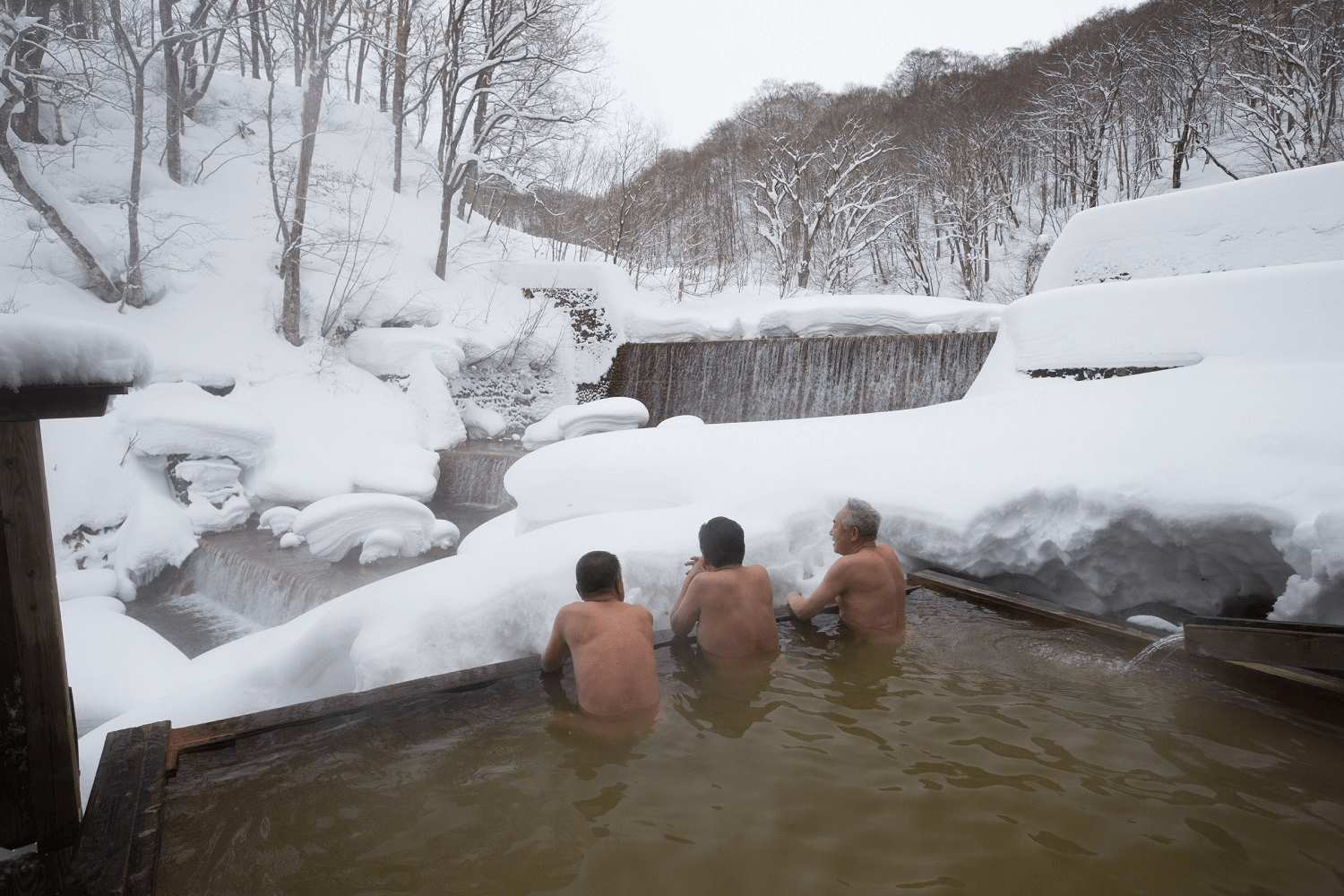
(Image courtesy of Nyuto Onsen Association)
Onsen (hot springs) can improve health and wellness depending on how you bathe. Enjoy the benefits of hot springs for your body and mind by bathing in a way that does not strain your body.
合)